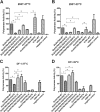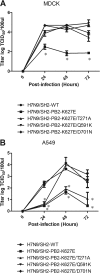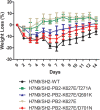Amino acid substitutions in polymerase basic protein 2 gene contribute to the pathogenicity of the novel A/H7N9 influenza virus in mammalian hosts
- PMID: 24403592
- PMCID: PMC3957932
- DOI: 10.1128/JVI.02740-13
Amino acid substitutions in polymerase basic protein 2 gene contribute to the pathogenicity of the novel A/H7N9 influenza virus in mammalian hosts
Abstract
A novel avian-origin influenza A/H7N9 virus emerged in 2013 to cause more than 130 cases of zoonotic human disease, with an overall case fatality rate of around 30% in cases detected. It has been shown that an E-to-K amino acid change at residue 627 of polymerase basic protein 2 (PB2) occurred frequently in the H7N9 isolates obtained from humans but not in viruses isolated from poultry. Although this mutation has been reported to confer increased mammalian pathogenicity in other avian influenza subtypes, it has not been experimentally investigated in the H7N9 virus. In this study, we determined the contribution of PB2-E627K in H7N9 virus to its pathogenicity in mammalian hosts. In addition, the compensatory role of the PB2 mutations T271A, Q591K, and D701N in H7N9 virus was investigated. We characterized the activity of polymerase complexes with these PB2 mutations and found that they enhance the polymerase activity in human 293T cells. The rescued mutants enhanced growth in mammalian cells in vitro. Mice infected with the H7N9 mutant containing the avian signature protein PB2-627E showed a marked decrease in disease severity (weight loss) and pathology compared to mice infected with the wild-type strain (PB2-627K) or other PB2 mutants. Also, mutants with PB2-627E showed lower virus replication and proinflammatory cytokine responses in the lungs of the virus-infected mice, which may contribute to pathogenicity. Our results suggest that these amino acid substitutions contribute to mouse pathogenicity and mammalian adaptation.
Importance: A novel avian H7N9 influenza A virus emerged in east China in 2013 to cause zoonotic human disease associated with significant mortality. It is important to understand the viral genetic markers of mammalian adaptation and disease severity in this H7N9 virus. Since many human (but not avian) H7N9 virus isolates have an amino acid substitution at position E627K in the polymerase basic protein 2 (PB2) gene, we investigated the role of this and other functionally related mutations for polymerase activity in vitro, virus replication competence, and pathogenicity in the mouse model. We found that E627K and functionally related mutations are associated with increased polymerase activity, increased viral replication competence, and increased disease severity in mice.
Figures







References
-
- Gao R, Cao B, Hu Y, Feng Z, Wang D, Hu W, Chen J, Jie Z, Qiu H, Xu K, Xu X, Lu H, Zhu W, Gao Z, Xiang N, Shen Y, He Z, Gu Y, Zhang Z, Yang Y, Zhao X, Zhou L, Li X, Zou S, Zhang Y, Li X, Yang L, Guo J, Dong J, Li Q, Dong L, Zhu Y, Bai T, Wang S, Hao P, Yang W, Zhang Y, Han J, Yu H, Li D, Gao GF, Wu G, Wang Y, Yuan Z, Shu Y. 2013. Human infection with a novel avian-origin influenza A (H7N9) virus. N. Engl. J. Med. 368:1888–1897. 10.1056/NEJMoa1304459 - DOI - PubMed
-
- Yu L, Wang Z, Chen Y, Ding W, Jia H, Chan JF, To KK, Chen H, Yang Y, Liang W, Zheng S, Yao H, Yang S, Cao H, Dai X, Zhao H, Li J, Bao Q, Chen P, Hou X, Li L, Yuen KY. 2013. Clinical, virological, and histopathological manifestations of fatal human infections by avian influenza A(H7N9) virus. Clin. Infect. Dis. 57:1449–1457. 10.1093/cid/cit541 - DOI - PubMed
-
- Ip DK, Liao Q, Wu P, Gao Z, Cao B, Feng L, Xu X, Jiang H, Li M, Bao J, Zheng J, Zhang Q, Chang Z, Li Y, Yu J, Liu F, Ni MY, Wu JT, Cowling BJ, Yang W, Leung GM, Yu H. 2013. Detection of mild to moderate influenza A/H7N9 infection by China's national sentinel surveillance system for influenza-like illness: case series. BMJ 24:f3693. 10.1136/bmj.f3693 - DOI - PMC - PubMed
-
- Zhou J, Wang D, Gao R, Zhao B, Song J, Qi X, Zhang Y, Shi Y, Yang L, Zhu W, Bai T, Qin K, Lan Y, Zou S, Guo J, Dong J, Dong L, Zhang Y, Wei H, Li X, Lu J, Liu L, Zhao X, Li X, Huang W, Wen L, Bo H, Xin L, Chen Y, Xu C, Pei Y, Yang Y, Zhang X, Wang S, Feng Z, Han J, Yang W, Gao GF, Wu G, Li D, Wang Y, Shu Y. 2013. Biological features of novel avian influenza A (H7N9) virus. Nature 499:500–503. 10.1038/nature12379 - DOI - PubMed
-
- Shi Y, Zhang W, Wang F, Qi J, Wu Y, Song H, Gao F, Bi Y, Zhang Y, Fan Z, Qin C, Sun H, Liu J, Haywood J, Liu W, Gong W, Wang D, Shu Y, Wang Y, Yan J, Gao GF. 2013. Structures and receptor binding of hemagglutinins from human-infecting H7N9 influenza viruses. Science 342:243–247. 10.1126/science.1242917 - DOI - PubMed
Publication types
MeSH terms
Substances
LinkOut - more resources
Full Text Sources
Other Literature Sources
Medical

